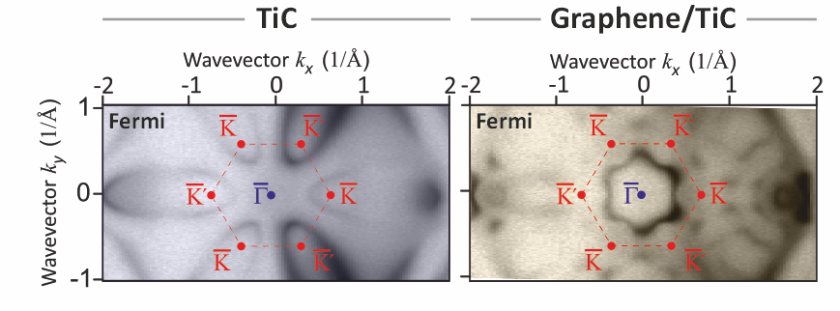Graphene on titanium carbide triggers a novel phase transition

Graphene-induced Lifshitz-transition from a petal-shaped Fermi surface to a gear-shaped hole Fermi surface revealed by comparative full photoemission mapping of the band structures of bare TiC(111) and graphene/TiC(111). © HZB
Researchers have discovered a Lifshitz-transition in TiC, driven by a graphene overlayer, at the photon source BESSY II. Their study sheds light on the exciting potential of 2D materials such as graphene and the effects they can have on neighboring materials through proximity interactions.
Stacking 2D materials has garnered a lot of attention in recent years as it provides a unique opportunity to tailor material properties in a highly controllable manner. However, the influence of 2D materials on the properties of neighboring materials through proximity effects is not yet fully understood. In particular, very sensitive properties such as band gaps in semiconductors and excitonic properties have been observed to be influenced. Fermi surfaces of bulk metals have so far not been among the properties sensitive to a proximity effect.
The Fermi surface of a metal is a mathematical concept to represent the electrons of the highest energy in the material. Only these electrons participate in properties such as electrical conductivity. An important aspect of the Fermi surface is that it represents them in terms of the direction of their movement.
The new study by Andrei Varykhalov and his colleagues at BESSY II shows that a graphene layer can induce a Lifshitz transition in the near-surface region of an underlying metal, TiC: The Fermi surface transforms from a hole-like to an electron-like Fermi surface. The reported change in Fermi surface character is particularly relevant since it changes the orientation of the movement of the electrons and in the presence of a magnetic field it changes the orientation of the macroscopic electric current.
The present finding is an exciting development as it provides a new avenue for controlling and manipulating the electronic properties of materials, which has implications for a range of technological applications, for example designing materials with quantum properties such as high temperature superconductivity.
red.
https://www.helmholtz-berlin.de/pubbin/news_seite?nid=24892;sprache=en
- Copy link
-
Ernst Eckhard Koch Prize and Innovation Award on Synchrotron Radiation 2025
At the 27th BESSY@HZB User Meeting, the Friends of HZB honoured the dissertation of Dr Enggar Pramanto Wibowo (Friedrich-Alexander University Erlangen-Nuremberg). The Innovation Award on Synchrotron Radiation 2025 went to Prof. Tim Salditt (Georg-August-University Göttingen) and Professors Danny D. Jonigk and Maximilian Ackermann (both, University Hospital of RWTH Aachen University).
-
Bright prospects for tin perovskite solar cells
Perovskite solar cells are widely regarded as the next generation photovoltaic technology. However, they are not yet stable enough in the long term for widespread commercial use. One reason for this is migrating ions, which cause degradation of the semiconducting material over time. A team from HZB and the University of Potsdam has now investigated the ion density in four different, widely used perovskite compounds and discovered significant differences. Tin perovskite semiconductors produced with an alternative solvent had a particular low ion density — only one tenth that of lead perovskite semiconductors. This suggests that tin-based perovskites could be used to make solar cells that are not only really environmentally friendly but also very stable.
-
Synchrotron radiation sources: toolboxes for quantum technologies
Synchrotron radiation sources generate highly brilliant light pulses, ranging from infrared to hard X-rays, which can be used to gain deep insights into complex materials. An international team has now published an overview on synchrotron methods for the further development of quantum materials and technologies in the journal Advanced Functional Materials: Using concrete examples, they show how these unique tools can help to unlock the potential of quantum technologies such as quantum computing, overcome production barriers and pave the way for future breakthroughs.
